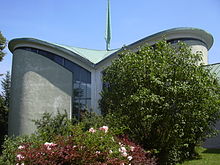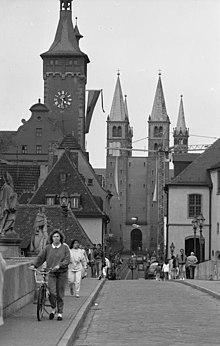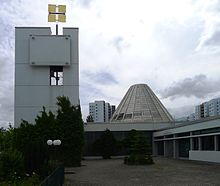Hans skull

Hans skull , also Johannes , (born February 14, 1910 in Randersacker ; † December 31, 1996 there ) was the diocesan and cathedral master builder of the diocese of Würzburg and the leading figure of the sacred building in Germany after the Second World War . Between 1948 and 1973, 56 churches were established in his and other dioceses under his leadership.
Life
Hans skull, son of a stonemason learned his father's craft. He married the daughter of a winemaker . From 1928 to 1933 he attended the technical college in Nuremberg . There he was the only one of ninety-two candidates to design a church as a thesis. He actually wanted to study theology in the Münsterschwarzach monastery , which his father prevented. In 1931 he passed the master's examination in stone masonry. In 1934 he got a job in the municipal building department of Würzburg. In 1938 he became an employee of Hubert Groß , the head of the city planning office in Würzburg. In 1939 he played a decisive role in the planning for the redesign of the Gau capital Würzburg in accordance with the Fuehrer's decree of October 4, 1937. However, due to the beginning of the Second World War, none of his ideas for the urban transformation of Würzburg were implemented. In 1945 he participated in the planning of the reconstruction of the traffic and external development for the city of Würzburg, which was badly destroyed in the war. His plans were not implemented.
In 1945 the cathedral chapter of Würzburg gave him an order to cover the destroyed cathedral and the Haug collegiate monastery . In 1946 he moved from the municipal building department to the newly created episcopal building department . In 1956 he was appointed master builder for the cathedral, and in 1971 diocesan builder. In total there were 87 churches that he rebuilt, redesigned or rebuilt. Most of it is in the diocese of Würzburg, but he was also active in the dioceses of Augsburg , Bamberg, Berlin, Fulda, Limburg, Mainz, Paderborn, Trier and in dioceses in Africa and India. In 1974 he resigned from the church service.
Skull described himself as a very devout Christian and his works as an attempt to praise the Creator of the world. He was married to his wife for over fifty years; they had three daughters and two sons. Skull died on December 31, 1996 in his hometown Randersacker, where he is also buried. His successor as master builder was Friedrich Ebert (* 1913).
In 1962, Cardinal Grand Master Eugène Cardinal Tisserant made Hans Skull Knight of the Order of Knights of the Holy Sepulcher in Jerusalem and invested it on December 15, 1962 in Cologne by Lorenz Jaeger , Grand Prior of the German Lieutenancy . Most recently he was an officer of the order.
Awards
- Accolade as a Knight of the Holy Sepulcher (1962)
- Culture Prize Winner of the City of Würzburg (1972)
- Gebhard Fugel Art Prize (1986)
- Gold medal for architecture at the Salzburg Biennale
- Commander's Cross of the Papal New Year's Order
- Bavarian Order of Merit
- Federal Cross of Merit 1st Class of the Order of Merit of the Federal Republic of Germany
- Honorary master of the Lower Franconian craft
plant
The rebuilding of the Würzburg Cathedral was the focus of Hans Schädel's work. After the first renovation work on the roof in 1945, the northern nave wall collapsed on a stormy night in 1946 and tore a large part of the barrel vault with it. The rebuilding of the cathedral was the subject of heated debate in the 1950s and 1960s. Particularly controversial at the time were the romanized western front and the ascetic redesign of the nave, for which the rich rococo plastering of pillars and vaults was not rebuilt.
St. Kilian in Schweinfurt became known nationwide and is generally regarded as successful. The church has one of the largest church windows in Germany with the 250 m 2 choir window with the motif of the pouring out of the Holy Spirit by Professor Georg Meistermann .
In the sacred space concept of the Maria Regina Martyrum memorial church in Berlin, skulls brought together great artists such as Fritz Koenig , who created the Pieta, Otto Herbert Hajek , who designed the Stations of the Cross, and Georg Meistermann, whose glass windows can be seen in the central altar area. The entire area is considered an outstanding example of a successful unity of church building and architectural sculpture. The church building is in a cobbled, sloping at low levels Feierhof that by using black and gray basalt gravel plates clad on head-high concrete walls is framed and on a parade ground recalls.
One of the curiosities in Skull's work is that the stones from the Laurentius Church in Heidingsfeld were intended for National Socialist buildings. Skull's opponent in the field of the new church building was Albert Boßlet , who, according to Skull's daughters, refused to ever enter its main building, St. Alfons in Würzburg.
buildings
- after the Second World War: Reconstruction of the parish church of St. Laurentius in Würzburg / Heidingsfeld
- 1946–1967: Reconstruction of the Kiliansdom in Würzburg Lage
- 1950–1952: St. Anton in Schweinfurt location
- 1950: St. Vinzenz in Kitzingen location
- 1952–1953: St. Kilian in Schweinfurt
- 1952–1954: St. Alfons in Würzburg- Keesburg location
- 1952: Maria Rosary Queen in Stockstadt am Main location
- 1954–1956: Holy Trinity in Kleinheubach Lage
- 1954: Expansion of the Hessenthal Lage Pilgrimage Church
- 1957: New pilgrimage church Maria zum Raue Wind in Kälberau Lage
- 1958–1959: New construction of the choir in Maria Ehrenberg Lage
- 1959–1963: Memorial Church Maria Regina Martyrum in Berlin - Charlottenburg-Nord location
- 1959: St. Anna in Braunfels location
- 1960: Holy Family in Würzburg- Heidingsfeld location
- 1962–1964: St. Hedwig in Kleinlangheim location
- 1964–1966: St. Johannes dT in Lahr (Westerwald) location
- 1964–1968: St. Michael in Schweinfurt location
- 1975–1977: Church of the Holy Martyrs of Africa in Berlin- Lichtenrade Lage
- 1975–1977: St. Dominicus in Berlin- Gropiusstadt location
- 1977: St. Markus in Berlin-Spandau location
- 1978–1979: Extension of the Martinskirche in Bad Orb , (1984–1985 reconstruction after fire) location
- 1980: St. Pius in the Rück-Schippach location
- Christ the King in Ruhstorf on the Rott location
- Parish church of Mary's motherhood in Hösbach-Bahnhof
- St. Blasius in Ochsenfurt- Zeubelried
- St. Georg in Schonungen location
- St. Laurentius in Kleinostheim location
- St. Margareta in Burgstadt
- St. Michael in Schweinfurt location
Fonts
- with Andreas Feldtkeller (ed.): Churches and community centers. Krämer, Stuttgart 1956.
literature
- Christiane Lange : On the work of Hans skull - contribution to church building in Germany in the fifties. DGV-Verlag, Weimar 1995, ISBN 978-3-92974260-2 .
Individual evidence
- ^ Hans skull died at the age of 86. Master builder of the Diocese of Würzburg dies , Baunetz, January 6, 1997
- ^ Niels Gutschow, Barbara Klein: Destruction and Utopia - Warsaw 1939-1945. Hamburg 1994, ISBN 3-88506-223-2 , p. 180, footnote 53.
- ↑ Sabine Gundlach: Dei cathedral builder skull and Ebert . In: Berliner Morgenpost. (January 7, 2016).
- ↑ City map Schweinfurt with sights and history. City of Schweinfurt 2009
- ↑ Sights. ( Memento of the original from October 8, 2008 in the Internet Archive ) Info: The archive link was inserted automatically and has not yet been checked. Please check the original and archive link according to the instructions and then remove this notice. berlin.de
- ^ Sibylle Schulz, Maria Lütjohann: leaflet. Published by the Archbishop's Office in Berlin (series of leaflets: Recognizing and Receiving in Berlin. 2008, No. 19).
Web links
- Literature by and about Hans skull in the catalog of the German National Library
- Hans skull. In: arch INFORM .
- Culture award winner: Hans skull
- German textbook: Hans skull - preserve and renew
- On the debate: Church buildings in the Diocese of Würzburg in the post-war period: Architecture as an expression of continuity and a new beginning by Barbara Kahle, 2009
| personal data | |
|---|---|
| SURNAME | Skull, Hans |
| ALTERNATIVE NAMES | Skull, Johannes |
| BRIEF DESCRIPTION | German architect |
| DATE OF BIRTH | February 14, 1910 |
| PLACE OF BIRTH | Randersacker |
| DATE OF DEATH | December 31, 1996 |
| Place of death | Randersacker |







